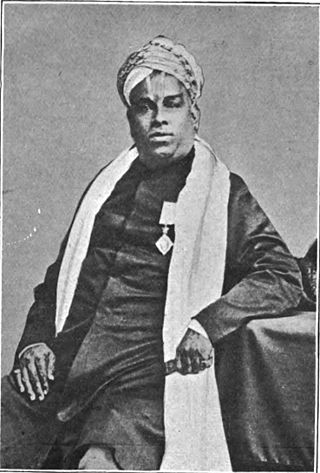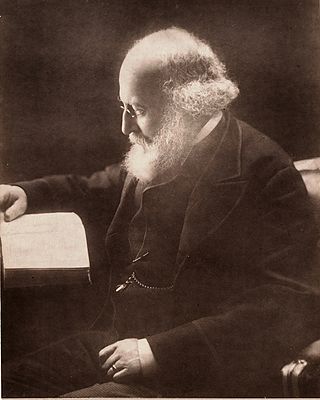Related Research Articles

Sir Walter Elliot, KCSI was a British civil servant in colonial India. He was also an eminent orientalist, linguist, archaeologist, naturalist and ethnologist who worked mainly in the Presidency of Madras. Born in Edinburgh, he studied at the East India Company College at Haileybury and joined the East India Company's civil service at Madras in 1820 and worked on until 1860. He was invested Knight Commander of the Order of the Star of India (KCSI) in 1866.

Robert Wight MD FRS FLS was a Scottish surgeon in the East India Company, whose professional career was spent entirely in southern India, where his greatest achievements were in botany – as an economic botanist and leading taxonomist in south India. He contributed to the introduction of American cotton. As a taxonomist he described 110 new genera and 1267 new species of flowering plants. He employed Indian botanical artists to illustrate many plants collected by himself and Indian collectors he trained. Some of these illustrations were published by William Hooker in Britain, but from 1838 he published a series of illustrated works in Madras including the uncoloured, six-volume Icones Plantarum Indiae Orientalis (1838–53) and two hand-coloured, two-volume works, the Illustrations of Indian Botany (1838–50) and Spicilegium Neilgherrense (1845–51). By the time he retired from India in 1853 he had published 2464 illustrations of Indian plants. The standard author abbreviation Wight is used to indicate this person as the author when citing a botanical name.

Velayudhan Chempakaraman Thampi ofThalakulam (1765–1809) was the Dalawa or Prime Minister of the Indian kingdom of Travancore between 1802 and 1809 during the reign of Bala Rama Varma Kulasekhara Perumal. He is best known for being one of the earliest individuals to rebel against the British East India Company's authority in India.

Vembaukum RamiengarCSI was an Indian civil servant and administrator who served as the Diwan of Travancore from 1880 to 1887.

Edward John Waring was a Fellow of the Royal College of Physicians of London and a surgeon in the British East India Company. He wrote several books on medicine including A Manual of Practical Therapeutics (1865), Pharmacopoeia of India (1866), and the two-volume Bibliotheca Therapeutica (1878).
Sir Adam Bittleston was a British-born Indian judge.
Charles Pelly was a British civil servant of the Indian Civil Service who served as the revenue member of the Madras Legislative Council from 1862 to 1866. He was reappointed as an additional Member in 1866.
James Talboys Wheeler was a bureaucrat-historian of the British Raj.
Robert Andrews was the Resident and Superintendent of British Ceylon. He was appointed on 12 February 1796 and was Resident until 12 October 1798. He was succeeded by Frederick North as Governor of British Ceylon.

Major General William Cullen was a British Army Officer with the Madras Artillery Regiment, and from 1840 to 1860, Resident in the Kingdom of Travancore and Cochin. During his stay in India, he took a scholarly interest in the region and contributed to journals on geology, plants and the culture of the region. He was instrumental in establishing the Napier Museum in Trivandrum. He died at Allepey in Kerala, where a road is named after him.

Thomas Evans Bell was an English Indian army officer and writer. He used the pseudonyms Undecimus and Indicus (1865).

George Parbury (1807–1881) was a British publisher with a special interest in India, a freemason in India and London, Master of Merchant Taylors livery company, Justice of the Peace for two counties and Deputy Lieutenant of the Tower Hamlets.
William H. Allen and Company was a bookselling and publishing business in London, England, at first known for issuing works related to the British colonies. It operated from headquarters in Leadenhall Street, later moving to Waterloo Place. Early owners and staff included James P. Allen, William Ferneley Allen, and William Houghton Allen.
Charles Edward Gover (1835–1872) was a British folklorist in Madras, India. He was one of the earliest translators of the Tirukkural into English.
The Sheriff of Madras was an apolitical titular position of authority bestowed for one year on a prominent citizen of Madras. The post was abolished in 1998.

Colonel Heber Drury was a British army officer who worked in India and contributed to botany in his spare time. He published two books and several articles on botany and is commemorated in the name of the only peninsular Indian species of slipper orchid in the genus Paphiopedilum, P. druryi, which he collected in the hills of Agastyamalai.
George Udny (1803–1879) was a British civil servant in India, barrister and author.

Louis Sansoni served as the second Postmaster General of Ceylon, between 1816 and 1825.
John Shortt was an Anglo-Indian physician who served in the Madras Presidency in southern India. He conducted research on snake venoms, wrote on a variety of other subjects including anthropology, agriculture, and animal husbandry. A species of shieldtail snake endemic to the Shevaroy Hills is named after him, Uropeltis shorttii.
References
- Adam Bisset Thom (2008). The County a Borough Magistrates List and Official a Parliamentary Register. BiblioBazaar, LLC. p. 190. ISBN 978-0-559-32820-6.
- Madras High Court reports: reports of cases decided in the High Court of Madras. Higginbotham's. 1864. pp. iii.